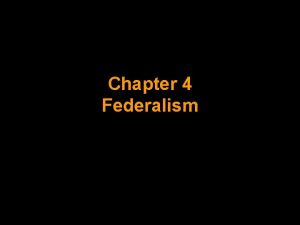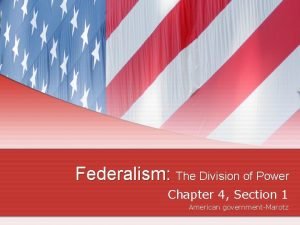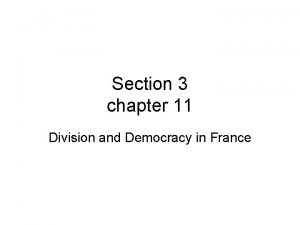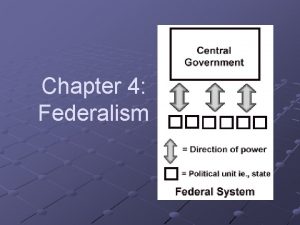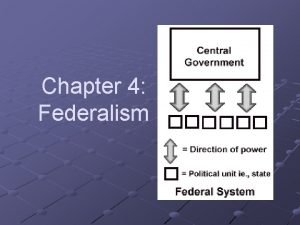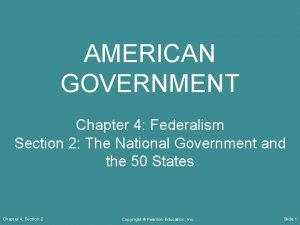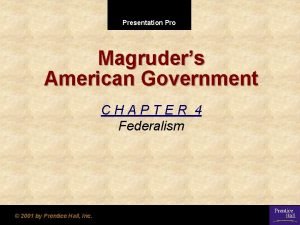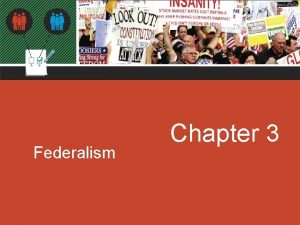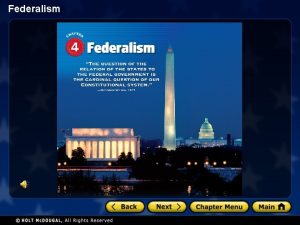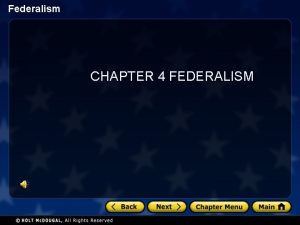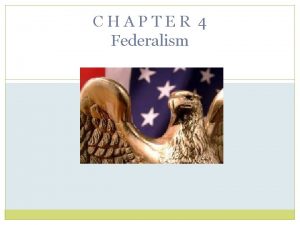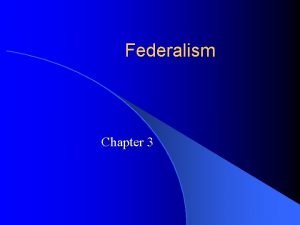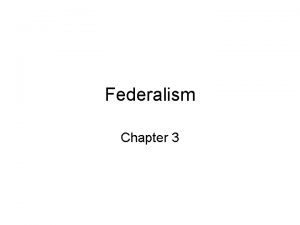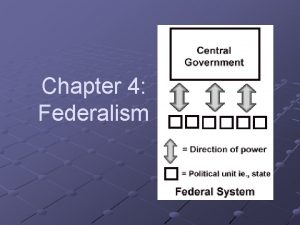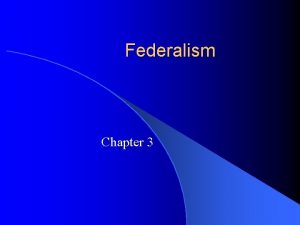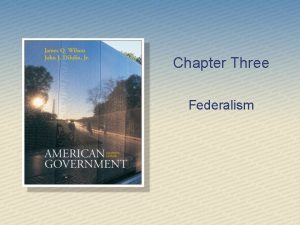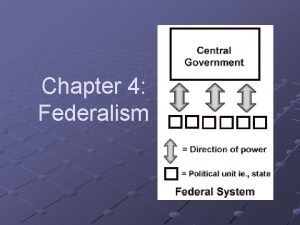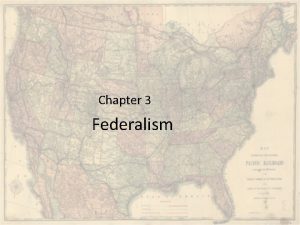Chapter 4 Federalism Section 1 Federalism The Division

















- Slides: 17

Chapter 4 Federalism

Section 1 Federalism: The Division of Power Objectives • Define federalism and explain why the Framers chose this system of government. • Identify powers delegated to and denied to the National Government, and powers reserved for and denied to the States. • Understand that the National Government holds exclusive powers; it also holds concurrent powers with the States. • Explain the place of local governments in the federal system. • Examine how the Constitution functions as “the supreme Law of the Land. ”

Section 1 Federalism: The Division of Power What is Federalism? • Federalism is a system of government in which a written constitution divides the powers of government on a territorial basis between a central, or national, government and several regional governments, usually called states or provinces. • Federalism allows local action in matters of local concern, and national action in matters of wider concern. It also sets up a division of powers between national and state governments.

Section 1 Federalism: The Division of Power Identify National/State Powers • The National Government only has powers that are delegated to it by the Constitution • In Article 1, Section 8, the Constitution gives Congress the expressed power to lay/collect taxes, to coin money, to regulate foreign/interstate commerce, to raise and maintain armed forces, and more. • Implied powers are given through the Necessary and Proper Clause (i. e. regulation of labor-management relations and building of hydroelectric power dams. • Inherent powers include regulation of immigration because it is suggested by the expressed power to regulate foreign trade.

Section 1 Federalism: The Division of Power Identify National/State Powers (cont’d) • The States are given reserved powers which are not granted to the National government nor denied to the States. • States can forbid marriage under 18 without parental consent or prohibit alcohol sales to those under 21. • However, no state can enter into a treaty, alliance, or confederation. States cannot print or coin money or deprive a person of life, liberty, or property without due process of law.

Section 1 Federalism: The Division of Power Exclusive/Concurrent Powers • Exclusive powers are given to the National government alone and cannot be exercised by the states. Such powers include the coinage of money, making of treaties, and laying duties on imports. • Concurrent powers are shared by both the National and state governments. Such powers include the levying of taxes, defining crimes and setting punishments, and condemning private property for public use.

Section 1 Federalism: The Division of Power Local governments in federalism • Local government can provide services, regulate activities, collect taxes, and do many other things. However, it can only do these things because the state has given it the power to do so. • When local governments exercise their power, they are actually exercising State powers. • Every state has a unitary form of government– a central government that creates local units of government for its own convenience.

Section 1 Federalism: The Division of Power Constitutional functions in the law of the land • The Constitution stands above all other forms of law in the United States. Acts of Congress and treaties stand immediately under it. • The Supremacy Clause joins the national government and the states into a single governmental unit, a federal government. • The Supreme Court acts as an umpire in the federal system. • Mc. Culloch v. Maryland helped to preserve the federal system in the debate of the establishment of a national bank.

Section 2 The National Government and the 50 States Objectives • Summarize the obligations that the Constitution places on the nation for the benefit of the United States. • Explain the process for admitting new States to the Union. • Examine the many and growing areas of cooperative federalism.

Section 2 The National Government and the 50 States Obligations of the Nation • The National Government must “guarantee to every State in this Union a Republican Form of Government. ” • The National Government must also provide protection for each State against invasion and internal disorder. • The National Government is also constitutionally bound to respect the territorial integrity of each of the States.

Section 2 The National Government and the 50 States Admitting New States • Only Congress has the power to admit new states into the Union. • A new state cannot be created by taking territory from one or more of the existing states without the consent of the state’s legislature. • To be admitted, an area must request statehood. Then Congress can pass an enabling act to have the people frame a Constitution. After a Constitution is approved by the area, it is sent to Congress. Then an act of admission may be passed. • Congress can set conditions before a state is admitted (i. e. Utah had to outlaw polygamy (having more than one spouse at a time).

Section 2 The National Government and the 50 States Areas of cooperative federalism • There are many grants-in-aid programs that grant federal money or other resources to the states. These grants often help them perform everyday activities. • Congress can also give an annual share of the huge federal tax revenue to the states known as revenue sharing. • There are three types of federal grants: 1. Categorical grants are made for some specific, closely defined purpose (i. e. school lunches or airport construction). 2. Block grants are made for much more broader defined purposes, such as health care, social services, or welfare. 3. Project grants are grants made to states, localities, or private agencies that apply for them (i. e. for scientific research on cancer).

Section 3 Interstate Relations Objectives • Explain why States make interstate compacts. • Understand the purpose of the Full Faith and Credit Clause. • Define extradition and explain its purpose. • Discuss the purpose of the Privileges and Immunities Clause.

Section 3 Interstate Relations Interstate compacts • Even though states cannot enter into treaties, alliances, or confederations, they can enter into interstate compacts with the permission of Congress. • All 50 States have entered into the Compact for the Supervision of Parolees and Probationers and the Compact on Juveniles, allowing them to share important law-enforcement data. • Other compacts’ subjects include coordination for the development of such resources as fish, wildlife, water, and oil; prevention of forest fires; combat pollution; provision for tax collections; promotion of motor vehicle safety; and much more.

Section 3 Interstate Relations Full Faith and Credit Clause • “Full Faith and Credit shall be given in each state to the public acts, records, and judicial proceedings of every state. ” • One example is that a person can prove age, place of birth, marital status, title to property, and similar facts by securing the necessary documents from the state where the record was made. It will be recognized in all 50 states. • The Full Faith and Credit Clause most often comes into play in court matters. • In Williams v. North Carolina, the Supreme Court upheld North Carolina’s decision to deny full faith and credit to the Nevada divorces.

Section 3 Interstate Relations Extradition • Extradition is the legal process by which a fugitive from justice in one State is returned to that State. This was designed to prevent a person from escaping justice by fleeing a State. • In Kentucky v. Dennison, the Supreme Court said that the federal government cannot order a governor to return in a fugitive. • In Puerto Rico v. Branstad, the Supreme Court overturned their previous ruling and state that the government can indeed order a government to extradite a fugitive.

Section 3 Interstate Relations Privileges and Immunities Clause • The Privileges and Immunities Clause means that no State can draw unreasonable distinctions between its own residents and those persons who happen to live in other States. • Each state must recognize the right of any American to travel in or become a resident of that state. • However, a state can require a person to live within the state for some time before he or she can vote or hold public office (reasonable distinction).
 Chapter 4 section 1 federalism the division of power
Chapter 4 section 1 federalism the division of power Chapter 4 federalism the division of power
Chapter 4 federalism the division of power Federalism powers divided worksheet
Federalism powers divided worksheet Federalism the division of power worksheet
Federalism the division of power worksheet Nationalist position definition
Nationalist position definition Chapter 8 cell growth and division section 8-2 answer key
Chapter 8 cell growth and division section 8-2 answer key Dryfus affair
Dryfus affair Chapter 4 federalism
Chapter 4 federalism Chapter 4 federalism
Chapter 4 federalism Chapter 4 federalism answer key
Chapter 4 federalism answer key Chapter 4 federalism
Chapter 4 federalism 369 times 2
369 times 2 How to use synthetic division
How to use synthetic division Long division vocabulary
Long division vocabulary Synthetic division with polynomials
Synthetic division with polynomials Section quick check chapter 10 section 1 meiosis answer key
Section quick check chapter 10 section 1 meiosis answer key Hát kết hợp bộ gõ cơ thể
Hát kết hợp bộ gõ cơ thể Frameset trong html5
Frameset trong html5
